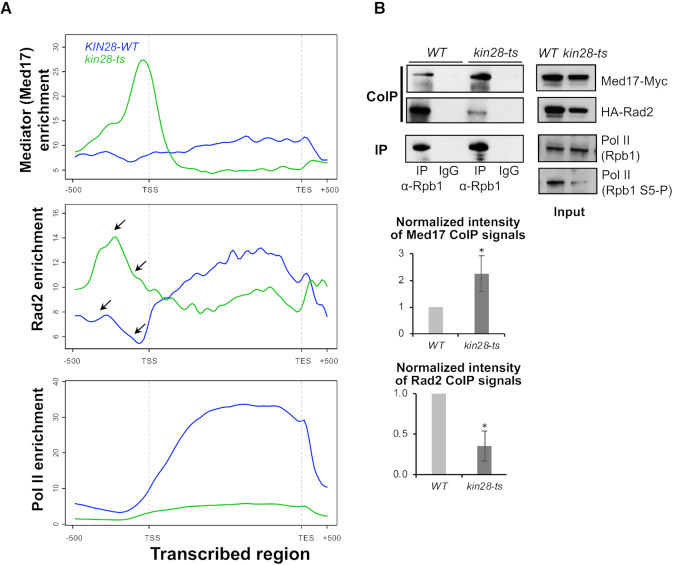Figure 2.
Effects of kin28-ts mutation on genome-wide Mediator, Rad2 and Pol II occupancy on transcribed regions and Mediator/Rad2/Pol II interactions. (A) Average tag density in Med17 Mediator ChIP (upper panel), Rad2 ChIP (middle panel) and Rpb1 Pol II ChIP (lower panel) on transcribed regions (scaled windows for 500 bp before TSS, between TSS and TES, and 500 bp after TES, 10% Pol II most-enriched regions in WT). Average tag density in WT strains is indicated in blue, whereas average tag density in kin28-ts strains is indicated in green. The black arrows point to the increase in Rad2 signal on regulatory and core promoter regions in kin28 mutant compared to the WT. (B) Effect of kin28-ts mutation on Mediator/Rad2/Pol II interactions. Western blot analysis of Mediator interaction with Rad2 and Pol II. Crude extracts were prepared from yeasts expressing tagged versions of Med17 (Myc) and Rad2 (HA) in the WT strain and kin28-ts mutant following a 75-min shift at 37°C, after reaching exponential phase at 25°C. Samples were immunoprecipitated with α-Rpb1 (Pol II) antibody (IP). Immunoprecipitates and Inputs were analysed by western blotting with α-Myc, α-HA and α-Rpb1 antibodies. The effect of kin28-ts mutation on Ser5 phosphorylation of Pol II CTD was verified by western blotting with an antibody against Ser5P-CTD (H14, Abcam). The intensity of immune staining for coimmunoprecipitated Med17 or Rad2 signals relative to the WT was normalized against immunoprecipitation signals and is displayed in the bottom panels. The mean values and standard deviation (indicated by error bars) of three independent experiments are shown. The asterisk represents a significant difference between the WT and the mutant at P-value < 0.05 in a Student's t-test.

